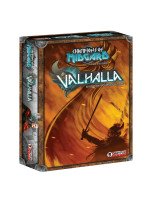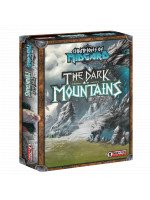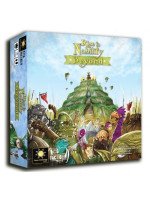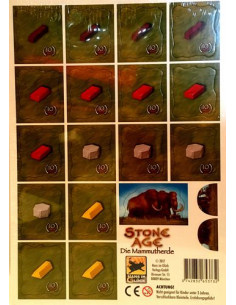
Stone Age: Die Mammutherde
A mammoth herd is passing by close to your village. You can tame these mammoths in order to have their help when constructing your village. But hurry up! Other tribes are on their way as well!
You can combine this mini expansion with the basic game as well as with all other expansions. First you set up the game as usual. You shuffle all 16 bonus tiles and place them face down next to the game board. The stand-up figure Mammoth herd is placed next to the pile. You are now ready to start the game. The game play stays the same except for the following changes.
At the beginning of each round the start player places the mammoth herd on the resource shown by the top-most bonus tile. For example if the tile shows a brick the start player puts the mammoth herd into the clay pit. Then he/she picks the first bonus tile and places it face up next to the pile. (The resource that is now shown is of no importance in this round.) If there are no bonus tiles left the whole herd is tamed. In this case you remove the mammoth herd and continue playing according to the normal rules. You place your people as usual. Only in the phase in which you use the actions of your people figures the mammoth herd becomes important. When you have people placed on the resource on which the mammoth herd stays you roll the dice as usual and take your resources. Immediately after this you may move one or more people from the resource where the mammoth herd is placed to the bonus tile that was turned over. With these people figures you can try to tame a mammoth later in order to have help for your work. You are only allowed to move people figures from this resource production area and you immediately have to pay 1 food for each people figure you place on the bonus tile. You may - as it is the case for feeding - substitute 1 food with 1 resource. People figures that are not placed on the bonus tile must be taken back to the player board. After all players have used the actions of their people but before the feeding you tame 1 mammoth from the mammoth herd.
All players who moved people to the bonus tile roll the dice. Each player uses as many dice as he has people on the bonus tile. All players roll the dice at the same time. Now you compare the score of your highest single die. (You do not add all dice together as usual and you are not allowed to use tools.) The player with the highest single die score wins and takes the "1." bonus. He may also instead take the "all" bonus. Then all the other players participating in the taming take the "all" bonus. Then the winner takes the tile and places it face down in front of himself. (The O on the back is not for the player. It just serves as a reminder for the final scoring). When the highest die scores are level the players compare the next lower score etc.
If there is still a draw after comparing all results all players involved get the "all" bonus.
The tile has to be put back into the box. If nobody has placed a people figure on the bonus tile nobody gets the bonus. The tile has to be put into the box as well. Before you score the civilization cards there is the mammoth scoring. The player with the most bonus tiles gets 10 points. In the case of a draw all players involved get these points.
- Deze editie is in het Engels en Duits.
- Geschikt voor 2 - 4 spelers.
- Je bent ongeveer 80 min. aan het spelen.
- Vanaf 10 jaar is dit spel te spelen.

Stone Age: Die Mammutherde
Op basis van 370 ervaringen op het toonaangevende Boardgamegeek.com
Dit spel wordt aangeraden voor (in %):
A mammoth herd is passing by close to your village. You can tame these mammoths in order to have their help when constructing your village. But hurry up! Other tribes are on their way as well!
You can combine this mini expansion with the basic game as well as with all other expansions. First you set up the game as usual. You shuffle all 16 bonus tiles and place them face down next to the game board. The stand-up figure Mammoth herd is placed next to the pile. You are now ready to start the game. The game play stays the same except for the following changes.
At the beginning of each round the start player places the mammoth herd on the resource shown by the top-most bonus tile. For example if the tile shows a brick the start player puts the mammoth herd into the clay pit. Then he/she picks the first bonus tile and places it face up next to the pile. (The resource that is now shown is of no importance in this round.) If there are no bonus tiles left the whole herd is tamed. In this case you remove the mammoth herd and continue playing according to the normal rules. You place your people as usual. Only in the phase in which you use the actions of your people figures the mammoth herd becomes important. When you have people placed on the resource on which the mammoth herd stays you roll the dice as usual and take your resources. Immediately after this you may move one or more people from the resource where the mammoth herd is placed to the bonus tile that was turned over. With these people figures you can try to tame a mammoth later in order to have help for your work. You are only allowed to move people figures from this resource production area and you immediately have to pay 1 food for each people figure you place on the bonus tile. You may - as it is the case for feeding - substitute 1 food with 1 resource. People figures that are not placed on the bonus tile must be taken back to the player board. After all players have used the actions of their people but before the feeding you tame 1 mammoth from the mammoth herd.
All players who moved people to the bonus tile roll the dice. Each player uses as many dice as he has people on the bonus tile. All players roll the dice at the same time. Now you compare the score of your highest single die. (You do not add all dice together as usual and you are not allowed to use tools.) The player with the highest single die score wins and takes the "1." bonus. He may also instead take the "all" bonus. Then all the other players participating in the taming take the "all" bonus. Then the winner takes the tile and places it face down in front of himself. (The O on the back is not for the player. It just serves as a reminder for the final scoring). When the highest die scores are level the players compare the next lower score etc.
If there is still a draw after comparing all results all players involved get the "all" bonus.
The tile has to be put back into the box. If nobody has placed a people figure on the bonus tile nobody gets the bonus. The tile has to be put into the box as well. Before you score the civilization cards there is the mammoth scoring. The player with the most bonus tiles gets 10 points. In the case of a draw all players involved get these points.
| Naam | Stone Age: Die Mammutherde |
|---|---|
| EAN | 742832653732 |
| Taal | Engels en Duits |
| Aantal spelers | 2 - 4 |
| Speeltijd | 80 min. |
| Minimale leeftijd | 10 jaar |
| Uitgever | Hans im Gluck |
Basisspellen voor Stone Age: Die Mammutherde

Stenen Tijdperk
De steentijd kenmerkt zich door beginnende akkerbouw, het produceren van nuttige grondstoffen en het bouwen van hutten. Handelen wordt steeds populairder en de beschaving ontwikkelt zich in rap tempo. Maar ook traditionele vaardigheden als jagen zijn vereist om stamleden te eten te kunnen geven.In dit bordspel probeer je te overleven in het Stenen Tijdperk. Daartoe zet je jouw stamleden op verschillende gebieden in. Je jaagt op wild om je volk van voedsel te voorzien, ontwikkelt gereedschap en verzamelt grondstoffen als hout, steen en zelfs goud, waarmee je functionele en waardevolle hutten bouwt. Uiteraard ontbreekt ook gezinsuitbreiding niet, noodzakelijk om later in het spel meer acties te mogen uitvoeren. Tijdens het spel zijn er talloze manieren om aan punten te komen, zoals het bouwen van hutten en het verzamelen van beschavingskaarten in combinatie met bepaalde ontwikkelingen. Je wint als je uiteindelijk de meeste punten hebt.In het Stenen Tijdperk zijn er veel manieren om je doel te bereiken, waardoor iedere speler een andere strategie kan kiezen. Aan het einde van het spel zal blijken welke de juiste was.Het Stenen Tijdperk is een prachtig spel voor zowel families als gevorderde spelers. Wegens aanhoudend succes brengen we het spel opnieuw op de markt.
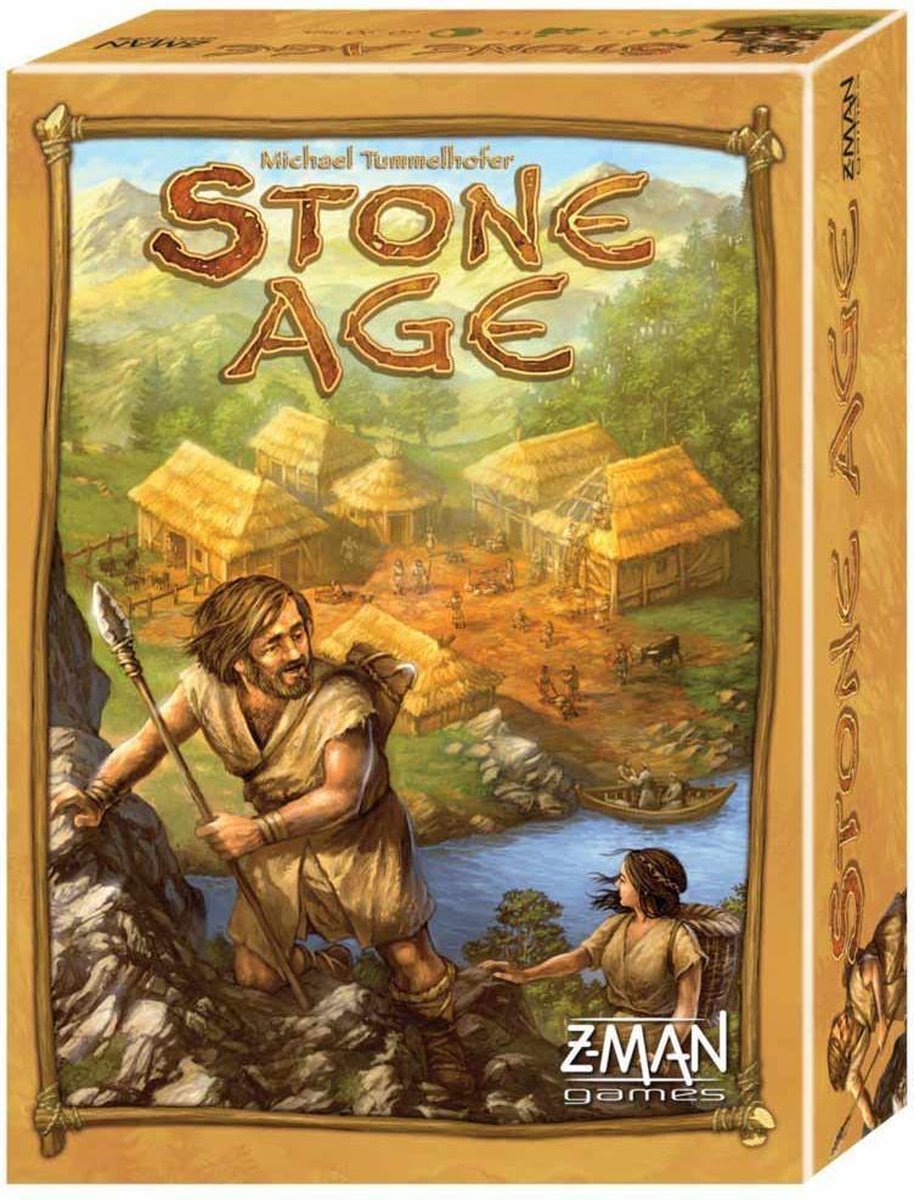
Stone Age
The "Stone Age" times were hard indeed. In their roles as hunters collectors farmers and tool makers our ancestors worked with their legs and backs straining against wooden plows in the stony earth. Of course progress did not stop with the wooden plow. People always searched for better tools and more productive plants to make their work more effective.In Stone Age the players live in this time just as our ancestors did. They collect wood break stone and wash their gold from the river. They trade freely expand their village and so achieve new levels of civilization. With a balance of luck and planning the players compete for food in this pre-historic time.Players use up to ten tribe members each in three phases. In the first phase players place their men in regions of the board that they think will benefit them including the hunt the trading center or the quarry. In the second phase the starting player activates each of their staffed areas in whatever sequence they choose followed in turn by the other players. In the third phase players must have enough food available to feed their populations or they face losing resources or points.AlgemeenAantal spelers: 2-4Speelduur: 60 min.Leeftijd: 10+Taal: EngelsSoort spelType/Thema: Dice Economic PrehistoricMechanisme: Contracts Dice Rolling End Game Bonuses Set Collection Turn Order: Progressive Worker PlacementMakersOntwerper: Bernd Brunnhofer
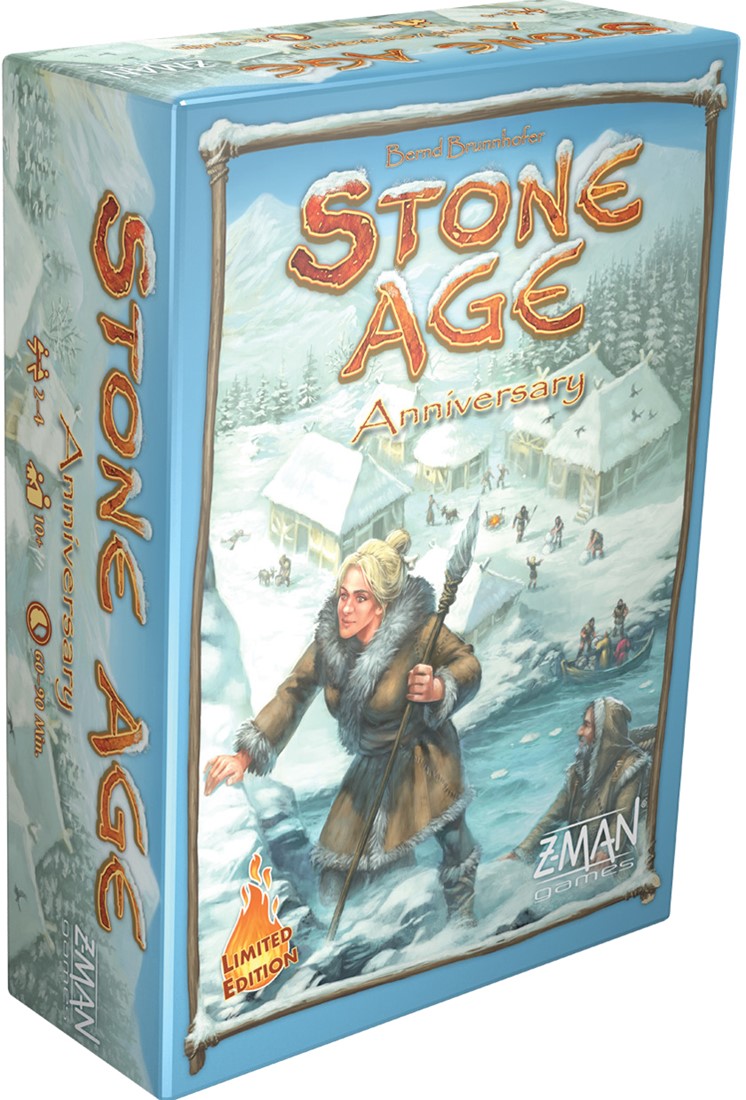
Stone Age - Anniversary Edition
In Stone Age, the players live in this time, just as our ancestors did. They collect wood, break stone and wash their gold from the river. They trade freely, expand their village and so achieve new levels of civilization. With a balance of luck and planning, the players compete for food in this pre-historic time.








